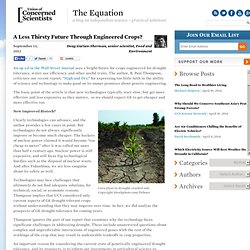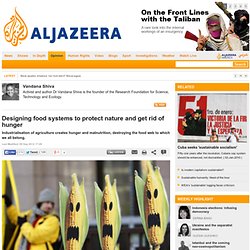

Wheat. Wheat (Triticum spp.)[1] is a cereal grain, originally from the Levant region of the Near East and Ethiopian Highlands, but now cultivated worldwide.

In 2010, world production of wheat was 651 million tons, making it the third most-produced cereal after maize (844 million tons) and rice (672 million tons).[2] Wheat was the second most-produced cereal in 2009; world production in that year was 682 million tons, after maize (817 million tons), and with rice as a close third (679 million tons).[3] This grain is grown on more land area than any other commercial food. History[edit] Wheat is one of the first cereals known to have been domesticated, and wheat's ability to self-pollinate greatly facilitated the selection of many distinct domesticated varieties. The archaeological record suggests that this first occurred in the regions known as the Fertile Crescent.
Origin[edit] Spikelets of a hulled wheat, einkorn Wheat continued to spread throughout Europe. Farming techniques[edit] Genetics[edit] The Family Farm Is Being Systematically Wiped Out Of Existence In America. An entire way of life is rapidly dying right in front of our eyes.

The family farm is being systematically wiped out of existence in America, and big agribusiness and the federal government both have blood all over their hands. According to the U.S. Department of Agriculture, the number of farms in the United States has fallen from about 6.8 million in 1935 to only about 2 million today. That doesn't mean that there is less farming going on. U.S. farms are producing more than ever. The way that the farming industry is structured today, it is simply not economically feasible to operate a small family farm.
Many old timers are trying to hang on for as long as they can. Most young people these days are not too eager to choose farming as a career. In recent years, many family farmers have been forced to find second jobs in order to support their families. Sadly, less than 25 percent of all farms in America bring in gross revenues in excess of $50,000. Oh the horror! Be Sociable, Share! Why 80 Percent of People Worldwide Will Soon Stop Eating Wheat. The future of wheat is certain, and it’s toxic.

There are as many health risks associated with the consumption of wheat as there are nutritional benefits claimed by the wheat industry. Why is there such a strong emphasis on the development of wheat products all over the world when there are so many adverse and crippling effects such as neurological impairment, dementia, heart disease, cataracts, diabetes, arthritis and visceral fat accumulation, not to mention the full range of intolerances and bloating now experienced by millions of people? Approximately 700 million tons of wheat are now cultivated worldwide making it the second most-produced grain after maize. It is grown on more land area than any other commercial crop and is considered a staple food for humans.
TreeHugger. A Less Thirsty Future Through Engineered Crops? An op-ed in the Wall Street Journal sees a bright future for crops engineered for drought tolerance, water use efficiency, and other useful traits.

The author, R. Paul Thompson, criticizes our recent report, “High and Dry,” for expressing too little faith in the ability of science and technology to make good on its unmet promises about genetic engineering. The basic point of the article is that new technologies typically start slow, but get more effective and less expensive as they mature, so we should expect GE to get cheaper and more effective too. Corn plant in drought-cracked soil. Copyright iStockphoto.com/Drbouz New Improved Biotech? Clearly technologies can advance, and the author provides a few cases in point. Technologies may face challenges that ultimately do not find adequate solutions, for technical, social, or economic reasons.
Thompson ignores the part of our report that examines why the technology faces significant challenges in addressing drought. Designing food systems to protect nature and get rid of hunger. Hunger and malnutrition is manmade.

It is in the design of the industrial chemical model of agriculture. And just as hunger has been created by design, producing healthy and nutritious food for all can be designed through food democracy. That is what we do in Navdanya. That is what the diverse movements for food sovereignty and agro-ecology are designing on the ground. We are repeatedly told we will starve without poisons and chemical fertilisers. Industrial production has led to such a severe ecological and social crisis, to ensure the supply of healthy food, we must move towards agro-ecological and sustainable systems of food production that work with nature, not against her.
Crop Nutrition and Fertilizer Requirements. Essential plant nutrients | Types of fertilizers | Soil nutrient content and soil testing | Fertilizer recommendations | Plant tissue analysis Essential Plant Nutrients Proper nutrition is essential for satisfactory crop growth and production.

The use of soil tests can help to determine the status of plant available nutrients to develop fertilizer recommendations to achieve optimum crop production. The profit potential for farmers depends on producing enough crop per acre to keep production costs below the selling price. Efficient application of the correct types and amounts of fertilizers for the supply of the nutrients is an important part of achieving profitable yields. There are at least 16 elements known to be essential for plant growth.
Macronutrients refer to those elements that are used in relatively large amounts, whereas micronutrients refer to those elements that are required in relatively small amounts (Table 1).